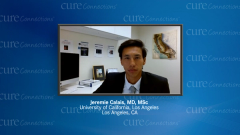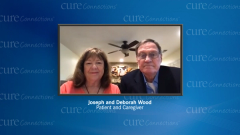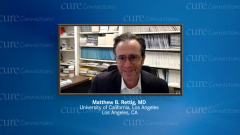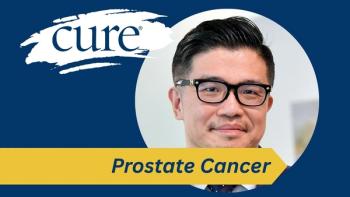
Follow-up and Side Effects in Patients Treated with Lutetium 177-PSMA 167
Joseph Wood and his wife and caregiver, Deborah, share their concerns and questions about radioligand therapy and how the COVID-19 pandemic has impacted their treatment experience.
Episodes in this series

Alicia Morgans, MD: Joe, how often are you going to have to go in for follow-ups and treatment while you’re on the trial?
Joseph Woods: We do not have a hard calendar yet. I expect to receive that on Monday when I get my first injection, but it’s my understanding that the injections are every 8 weeks, with scans and blood tests in between those 8 weeks, at variable times. We’ll just have to live around that schedule when it comes.
Alicia Morgans, MD: What side effects did your doctor talk to you about as you were thinking about this trial and signing the consent?
Joseph Wood: Dr Rettig and I discussed the dry mouth and the other side effects because I had already researched the lutetium. We had a short discussion about that, but it didn’t concern me. I was aware of them [already] and I’ve had other side effects, so it’s just a little more fatigue to push through, that’s all.
Alicia Morgans, MD: Were there any [side effects], was there anything? It sounds like you didn’t have any major concerns or other things that you were asking about. But Debbie, was there anything that you had questions or concerns about with this?
Deborah Wood: They’ve answered most of them. I think it helps the caregiver not to have this mystery around, this mysterious thing. They’ve been working, trying to cure cancer for years. Every step has been a great step for Joe. We’ve still been able to go fishing, and do some of the things we enjoy doing. I think this video call has cleared up a lot of my questions as far as taking care of Joe. It did help me in the interim; for example, I’m going to have our hotel room longer when we come down because I don’t want to [spend] 5 hours in the car. I’m glad because the more forewarned we are, the better I can take care of both of us. Thank you for clearing all that up.
Matthew B. Rettig, MD: I’d like to add something. From my perspective, as the treating physician, I appreciate and encourage caregivers to be involved. I appreciate it when they come to the clinic when it’s possible; it’s not always possible, of course. It certainly makes it easier to care for the patients with the caregiver involved in understanding what’s going on and addressing any questions they may have so that the treatments can go as smoothly as possible.
Deborah Wood: I would like to add to that. COVID-19 really drove me nuts, because [previously] I had made every doctor’s appointment with Joe. And he comes out [of his appointments], and he’s like, “Oh, [the doctor] just said this.” That was frustrating because, “No, you were in there, the doctor had to have said more than one sentence.” So, I’m glad that I will be able to come back in because it helps me understand what’s happening when Joe’s not so forthcoming with what happens in the appointment. I’m glad to be able to go back in.
Alicia Morgans, MD: Matt, do you have any comments on that? Because as a medical oncologist, I felt like that was one of the hardest parts of the pandemic, separating people from their support, and then trying to communicate. What are your thoughts?
Matthew B. Rettig, MD: I agree totally. Especially when I’m first meeting a patient, and I walk into the room, and I see the patient by himself, my heart sinks a little. I always would prefer to have a loved one near, as a provider. Hopefully, we’re getting through some of the worst of COVID-19, knock on wood, and this won’t be so much of an issue. I think that has already started to change. I share your sentiment, Alicia, about that and COVID-19.
Deborah Wood: I have a question for Jeremie. When you give [Joe] the treatments, will we be able to come in with him? Or is it better for our health to not be able to visit him while he’s having his infusions? He has a Kindle, he can play poker, whatever, but I’m just not sure how this works.
Jeremie Calais, MD, MSc: There is no strict rule. Treatment will last around two to three hours, so in the meantime, you can take a walk or be in the waiting room. But if you felt strongly you wanted to be by your husband’s side, you can definitely come into the room. Many patients are doing that. There is lead shielding protection from the source of the radiopharmaceutical therapy during the 30 minutes while the infusion pump is taking the drug. Again, it is the gamma radiation that we fear for the surrounding people, because most of the radiation we’re using is just emitting in an area of a couple of millimeters. This is the 1 that treats the cancer in Mr Wood’s body. The types of radiation we fear for the surrounding people are the X-ray-like ones, and with these, if you’re 2 or 3 meters away from the source, you’re already pretty safe. Many patients have their caregiver come in the room as well, sitting on a chair maybe 4 or 5 meters away, doing something on their computer or just staying by their side. It’s up to you.
Deborah Wood: Yes, a lot of times, it’s up to Joe. Sometimes he prefers to just listen to his iPod. It depends on him if I go, normally, because I’d be in everything. I’m kind of that kind of person.
Jeremie Calais, MD, MS: You’ll see, you can try both ways. You will have multiple cycles to try different scenarios.
Deborah Wood: You have a big lounge chair for me, right?
Jeremie Calais, MD, MSc: Yes, and it is California, so the weather is supposed to be nice.
Matthew B. Rettig, MD: Dr Calais gives massages to all caregivers.
Deborah Wood: It’s a good thing because I have a bone disease and it isn’t my friend. Dancing now, that’s OK. I can’t walk the next day, but I enjoy it.
Alicia Morgans, MD: This is certainly prime multidisciplinary care. Between the resources, the facilities, and the massages by Dr Calais, certainly, the care is better at UCLA [University of California, Los Angeles] than elsewhere, and we can all aspire to that.
Transcript edited for clarity.








